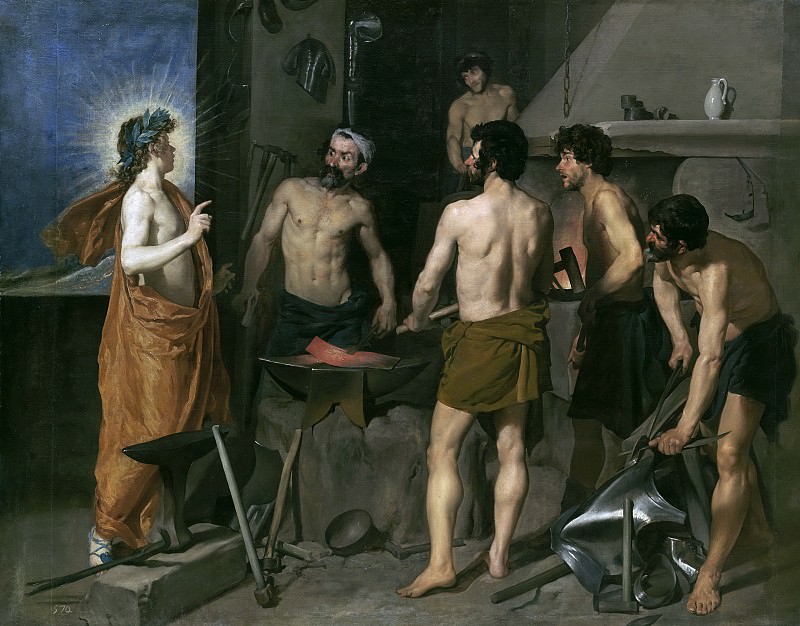Velázquez, Diego Rodríguez de Silva y – La fragua de Vulcano Part 3 Prado Museum
Part 3 Prado Museum – Velázquez, Diego Rodríguez de Silva y -- La fragua de Vulcano
Edit attribution
Download full size: 2916×2281 px (2,1 Mb)
Back to album: Part 3 Prado Museum
The painting was painted in 1630. The entire subject, taken from the mythology of ancient Greece, is interpreted by the painter in a very original way, becoming considerably more complex. In the painting, Velázquez depicts the moment when Apollo tells Vulcan, god of fire, that the goddess Venus is unfaithful to him. No earthiness is felt in the composition created, but one can sense that the author is being ironic.
Description of Diego Velázquez’s painting The Forge of Vulcan
The painting was painted in 1630.
The entire subject, taken from the mythology of ancient Greece, is interpreted by the painter in a very original way, becoming considerably more complex. In the painting, Velázquez depicts the moment when Apollo tells Vulcan, god of fire, that the goddess Venus is unfaithful to him.
No earthiness is felt in the composition created, but one can sense that the author is being ironic. Despite the fact that Apollo shines around him, his image is so prosaic. Vulcan and those who help him are also devoid of divinity. They are ordinary people. You get the full feeling that we got into the forge of the then Spanish blacksmith, who was caught at his usual occupation.
All the domestic concreteness of the setting is also reinforced. The myth told of a cave and a fire-breathing volcano. Velázquez, on the other hand, depicts an ordinary forge. Just beautifully depicted the hearth, which is located in the very depths of the forge. The room is lit by flames of pink-orange-yellow. The viewer can see even the tiniest sparks hanging in the air.
The overall tone of the canvas is a light brown tone, into which yellow shades are masterfully introduced, as well as brown and red. With the greatest force they sound in the cloak of the sun god, in the colorful sheet of iron, which is red-hot and hot flame. The painter also introduces shades of grayish-blue. It is, above all, the sky, Apollo’s wreath.
Velázquez masterfully developed for all the characters characteristic gestures, special poses and certain facial expressions. The viewer sees the hammers, frozen in different positions. This suggests that the work was suddenly interrupted.
One gets the feeling that this painting is not based on a mythological subject, but on a domestic theme. Such a new reading of an ancient subject was quite bold and new in the time of the painter.
Кому понравилось
Пожалуйста, подождите
На эту операцию может потребоваться несколько секунд.
Информация появится в новом окне,
если открытие новых окон не запрещено в настройках вашего браузера.
You need to login
Для работы с коллекциями – пожалуйста, войдите в аккаунт (open in new window).




















COMMENTS: 1 Ответы
Здравствуйте! Скажите пожалуйста, что за эффект такой, что у 2го человека справа от края ноги какие-то непонятные или их вообще нет??.. Картина не дописана может быть?
You cannot comment Why?
Here we see a group of men, largely unclothed, actively working at various tasks related to metalworking. Their bodies are rendered with considerable realism, emphasizing their musculature and the physical exertion involved in their labor. One man hammers a piece of red-hot metal over an anvil, while another appears to be shaping or holding a similar object. A third figure is partially obscured but seems to be observing the process. Further back, two men are visible, one leaning against a wall and another seemingly engaged in a less strenuous task. The overall impression is one of intense activity and focused effort.
The most striking element is the female figure positioned on the left side of the canvas. She radiates an almost supernatural light, emanating from behind her and illuminating parts of the scene. Her pose suggests direction or instruction; she gestures towards the work being performed with a pointed finger. The drapery around her body flows dramatically, contributing to her ethereal quality. A helmet rests upon her head, hinting at a connection to mythology or allegory.
The workshop itself is filled with tools and equipment associated with metalworking – hammers, tongs, helmets, shields, and various implements are suspended from the walls and scattered across the floor. The lighting within the space is uneven; areas of intense brightness contrast sharply with deep shadows, creating a dramatic effect and highlighting the physicality of the labor.
Subtleties in the work suggest layers of meaning beyond a simple depiction of craftspeople at their trade. The presence of the luminous female figure implies a divine or allegorical dimension to the scene – perhaps representing inspiration, skill, or the transformative power of artistic creation. The contrast between her idealized beauty and the rough physicality of the laborers could be interpreted as an exploration of the relationship between the ideal and the real, or between the intellectual and the manual arts. The inclusion of armor and weaponry suggests a connection to warfare or heroic narratives, further enriching the symbolic potential of the image. The artist’s meticulous attention to detail in rendering both the human form and the tools of the trade conveys a profound respect for craftsmanship and the dignity of labor.